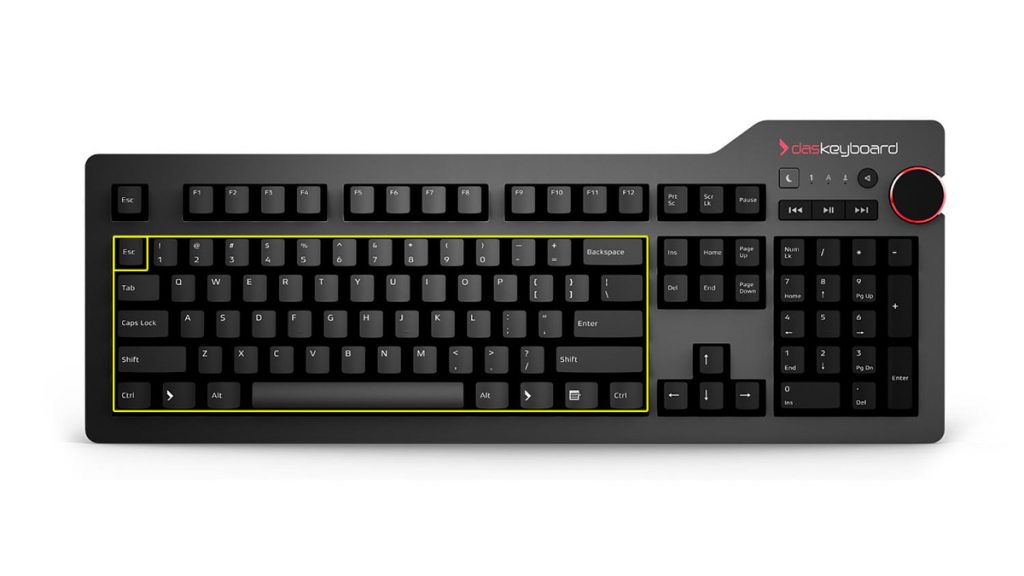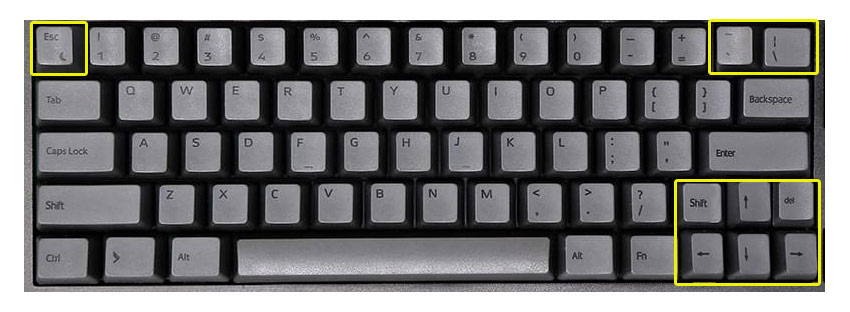
Because there are so many different sizes of keyboards some may not know how many keys are on a 60% keyboard. It can be difficult to make sense of the differences between a 60% keyboard, 65% keyboard, 75% keyboard, TKL, and how to determine which will suit your needs. Taking a closer look at one type of keyboard commonly called a 60% may help provide the insight to make an informed decision.
60 percent keyboards are typically mechanical keyboards and are less frequently made as membrane keyboards. The 60% keyboard is becoming more widely used because of its portability when working from home and working in the office. Because it is so compact it is easy to throw in a laptop bag or backpack and bring to a new workspace. There are a decent amount of options and factors to consider when choosing a keyboard, and this remains to be true when looking at different types of 60% keyboards.
What is a 60% Keyboard
A 60% keyboard may or may not have arrow keys and will never have the function row of keys. It is becoming more common to split the shift key and use the function, ctrl, or Windows keys for arrow keys. Because the escape key is found on the function row on standard keyboards, it is moved to the number row, replacing the `~ key on a 60% keyboard. For people who use code formatting on GitHub, Slack, or Discord, this could be problematic since displaying code in these platforms requires the use of a back-tick ` (although there are shortcuts for a back-tick on GitHub). Some 60% keyboards move the backspace down, replacing the \ | key with the backspace, and split the backspace key into the back-tick and tilde ~ key, as is illustrated in the top right corner of the below image.

60% keyboards are also missing what many consider one of the most important parts of a keyboard, the number pad. Even some advanced touch typists prefer to use a Numpad when they are entering many numbers throughout the day. While the popularity of smaller keyboard form factors is growing, this is the main reason why full-size keyboards are still so popular with programmers, engineers, students, finance, and business professionals among others.
How Many Keys on a 60% Keyboard
A typical 60% ANSI-derived (American National Standards Institute) layout keyboard has 61 keys on 5 rows. The top row and the second row both have 14 keys, the third row has 13 keys, the fourth row has 12 keys, and the bottom row has 8 keys. While this is technically 59% of a standard 104 key full-size keyboard, there could be a number of variations in the number of keys if a 60% is a custom keyboard, but generally speaking, an ANSI-derived 60% keyboard will have 61 keys and an ISO (International Organization for Standardization) layout could have 61-63 keys. If you are looking for a 60% keyboard with a JIS (Japanese Industrial Standard) layout you may have a very hard time as there are not a lot of JIS layout mechanical keyboards currently available, and so the options are limited.
In comparison, most full-size keyboards have 104, 105, or 108 keys depending on whether they are based on ANSI, ISO, or JIS layouts. Full-size keyboards contain a number pad, function keys, arrow keys, and a home cluster. Since their frames are larger, manufacturers typically fill the keyboards with additional features for marketing purposes. For example, some full-size keyboards even come with media control buttons.
Despite the additional features of full-size keyboards, many people choose 60 percent keyboards because they are smaller. 60% keyboards measure approximately 11.5 inches by 4.25 inches making them smaller than tenkeyless keyboards (TKLs). This smaller size gives typists more freedom in how they choose to position the keyboard.
60% Keyboard Customization Options
60% keyboards are very popular when building a custom keyboard, and if you are building your own keyboard there are a lot of options for keyboard cases in different materials and colors. There are also different types of PCBs (printed circuit boards) that could be unlit or have RGB lighting on the PCB itself to produce an underglow effect. A 60% keyboard can also be made with virtually any type of switch, and there are many keycap sets designed for 60% keyboards. While building a keyboard can be a fun hobby to get into, keep in mind that these parts are often much more expensive than an out-of-the-box keyboard that you would buy from a keyboard store, and just a custom 60% case could cost $295 or more. The parts are also not always readily available, so there may be long wait times ranging from a few months to a year.
Since 60% keyboards have fewer keys and out-of-the-box features manufacturers and DIY builds often make them programmable to compensate. Often, the programmable layer uses a PN- key. When you hold PN-, the function of each key changes. With this feature, it makes it possible for a 60% keyboard to use key combinations as shortcuts for function commands or special characters. Some 60% keyboards also have the ability to record macros so that one could record a series of keystrokes into a single key. The only issue that might arise with macros on a 60% keyboard is that there are so few keys, there are fewer free keys available to use to record a macro.
As the options and popularity of 60% keyboards continue to grow, this form factor has found a home for those who don’t have a lot of desk space, who want a portable keyboard, want more freedom of finger position, or are just looking for a small or programmable mechanical keyboard. For those who need a keyboard that’s pre-built and readily available with lots of out-of-the-box features, a TKL or a full-size keyboard may still be the best choice. While the custom 60% keyboard hobby may become very expensive very quickly, there is a large mechanical keyboard community with lots of information, tips, and ideas for builds. Building a custom 60% keyboard could even turn into an enjoyable hobby that gives you the ability to add a personal touch to your keyboard through aesthetics and feel, and allow you to build a one-of-a-kind keyboard.
